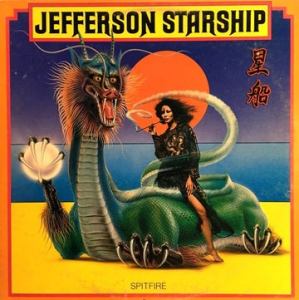More Jefferson Airplane
Reviews and Commentaries for The Jefferson Airplane
- Insanely good sound for this Shootout Winning copy of the Starship’s 1976 release — Triple Plus (A+++) sound on the first side and solid Double Plus (A++) sound on the second
- Forget whatever dead-as-a-doornail Heavy Vinyl they’re making – the Tubey Magic, size and rock and roll energy of this very special vintage pressing simply cannot be beat
- “Spitfire was Jefferson Starship’s 1976 follow-up to the chart-topping Red Octopus (1975), and it found the band in a cooperative mood… [it] was more than the sum of its parts, boasting the sort of vocal interplay and instrumental virtuosity that had always been the hallmarks of Jefferson Airplane and Jefferson Starship.”
What amazing sides such as these have to offer is not hard to hear:
- The biggest, most immediate staging in the largest acoustic space
- The most Tubey Magic, without which you have almost nothing. CDs give you clean and clear. Only the best vintage vinyl pressings offer the kind of Tubey Magic that was on the tapes in 1976
- Tight, note-like, rich, full-bodied bass, with the correct amount of weight down low
- Natural tonality in the midrange — with all the instruments having the correct timbre
- Transparency and resolution, critical to hearing into the three-dimensional studio space
No doubt there’s more but we hope that should do for now. Playing the record is the only way to hear all of the qualities we discuss above, and playing the best pressings against a pile of other copies under rigorously controlled conditions is the only way to find a pressing that sounds as good as this one does.
What We’re Listening For on Spitfire
- The Big Sound comes next — wall to wall, lots of depth, huge space, three-dimensionality, all that sort of thing.
- Then transient information — fast, clear, sharp attacks, not the smear and thickness so common to these LPs.
- Tight punchy bass — which ties in with good transient information, also the issue of frequency extension further down.
- Next: transparency — the quality that allows you to hear deep into the soundfield, showing you the space and air around all the instruments.
- Extend the top and bottom and voila, you have The Real Thing — an honest to goodness Hot Stamper.
- Energy for starters. What could be more important than the life of the music?
- Then: presence and immediacy. The vocals aren’t “back there” somewhere, lost in the mix. They’re front and center where any recording engineer worth his salt would put them.
TRACK LISTING
Side One
Cruisin’
Dance With The Dragon
Hot Water
St. Charles
Side Two
Song To The Sun
Ozymandias
Don’t Let It Rain
With Your Love
Switchblade
Big City
Love Lovely Love
AMG Review
Spitfire was Jefferson Starship’s 1976 follow-up to the chart-topping Red Octopus (1975), and it found the band in a cooperative mood. All seven bandmembers earned writing credits on at least one of the nine songs, along with eight outsiders, and even drummer John Barbata got a lead vocal on the simple rock & roll song “Big City.” But the three main power centers in the group remained in place. Singer/guitarist Paul Kantner continued to turn out his lengthy, complex songs with their exhortatory, vaguely political lyrics…
…Weaving the three styles together were the fluid lead guitar work of Craig Chaquico and the alternating bass and keyboard playing of David Freiberg and Pete Sears. The result was an album that quickly scaled the charts, spending six consecutive weeks at number three in Billboard and going platinum.
